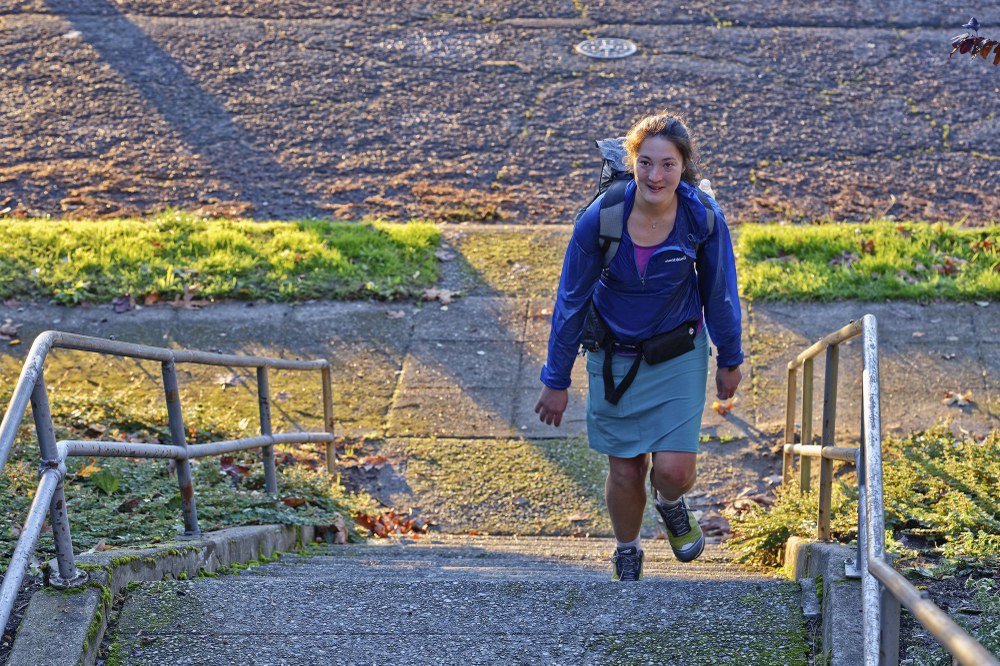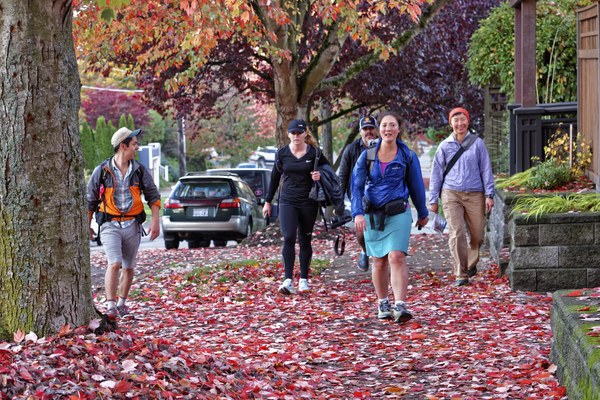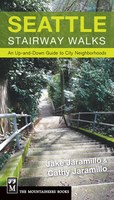
With the sun about to kiss the horizon, Liz Thomas, trail name: “Snorkel,” has places to go and needs the last rays of the day to illuminate her path. She is ascending and descending steps in Seattle, one of the hilliest and most publicly staircased cities in the country. This is not a task to be executed, at her pace, in complete darkness.
With urgency, Liz sheds her membrane-like jacket. She hands off her pack, a maneuver known in her usual mode of transportation – thru-hiking – as “slack-packing.” Unburdened, the 31-year-old Sacramento native is like a spacecraft engaging booster rockets, and it’s now clear how she held the women’s unsupported hiking speed record on the Appalachian Trail for five years.
Most of her entourage – a videographer recording the hike for posterity, a marketer from her footgear sponsor, and one of two local hiking groupies – fade into an afternoon memory. The only one close enough to feel Liz’s tailwind is Vivian Doorn, an ultramarathon runner. But as Doorn hits the bottom of an impossibly grueling sequence of staircases, Liz nears the top, her arms pumping like a derrick.
Liz is alone, out in front, a position to which she has become accustomed. In 2011, she did 2,181 miles on the Appalachian Trail, from Georgia to Maine, in 80 days, 13 hours, cementing a reputation as a trail-blazing woman in the American hiking community. The past couple years, Liz has logged more navigated, concrete mileage in more different places than anyone, in hopes of making a point to urban dwellers about the ease of recreating outdoors.
Liz’s is a cause that has found its time. Everyone from Michelle Obama to REI has been trying to get increasingly inert Americans, particularly youth and marginalized communities, off their backsides and screens big and small, and into wide, open spaces – for their own physical and mental good. Trouble is, many of the prompts and programs for the back-to-nature movement are complicated and daunting and therefore don’t have much lasting effect.
Every Kid in a Park, for example, is a federal program that depends on families of fourth graders to first recognize they are eligible for a free yearlong pass to federal public lands, then figure out how to acquire one, and finally use it, often requiring transportation and gear to which they often don’t have access, not to mention understanding the various categories of public lands, their recreational possibilities, and location.
Americans planning for the start of summer vacation season need not stress about destinations or means: Urban hiking is as simple as stepping out one’s front door.
Liz and others have added the dimension of thru-hiking – hiking long trails, continuously and end to end – to inspire and demonstrate with the highest ideal of their endeavor the way others might publicize marathons to promote jogging. Liz herself is a convert. She has completed hiking’s “Triple Crown,” which in addition to the Appalachian Trail includes the Pacific Crest Trail, which stretches 2,650 miles from the border between California and Mexico to that between Washington and Canada, and the Continental Divide Trail, which extends 3,100 miles from the border of New Mexico and Mexico to that between Montana and Canada. She just had a book about thru-hiking, Long Trails, published by Backpacker/Falcon. Liz estimates that she has logged some 15,000 miles on long-distance trails. Depending on when she’s asked, she might say that she prefers the urbanized strolls.
“I’ve hiked in rainforests, in deserts, and all kinds of ecosystems around the U.S., and have pioneered routes,” says Liz, who earned her Masters in environmental science from Yale. “And yet there is something appealing about a city to walk through. There is that same aspect of exploration, of not knowing what’s around the next corner. Most human interactions are possible, but there’s still the element of the unknown. You have to go through the same planning process as you would for going out in nature.
“I like the process of walking and seeing the world at 2-3 mph.” As an advocate of urban hiking, Liz has the further appeal of being a person of color (she’s Japanese American). She also has been inventive about how she’s stitched together landmarks to create themes for her thru-hikes. In Los Angeles, San Francisco, and Seattle, she followed public staircases; Pittsburgh, the city with the most communal flights, is considered urban thruhiking’s holy grail. In Chicago, Liz followed waterways. She crowdsourced city features in Portland, Oregon. In Denver, where she used to live, she’s followed Colfax, the longest boulevard in the country; an urban trail called Highline Canal, and in her latest theme hike, she visited 65 breweries (including one for kombucha) and one meadery in what she called the Brew Thru.
During the Brew Thru, Liz took a gulp at every waypoint, necessitating a “designated hiker,” who made sure Liz safely navigated “urban fords” – crossing highly trafficked thoroughfares – which she considers urban thru-hiking’s greatest hazard.
This kind of commitment, creativity, and public exposure is what the fathers of urban thru-hiking had in mind when in 2015 they invited Liz to take on the Inman 300, which they tout as the world’s first urban thru-hiking trail, linking more than 340 public staircases over some 220 miles in Los Angeles.
Andrew Lichtman, an L.A. attorney, and his wife Ying Chen thought about an urban connection while thru-hiking the 211- mile John Muir Trail in California’s Sierra Nevada. Dan Koeppel, a writer, had been tackling stairways while training for his own John Muir hike. Bob Inman had written a guidebook about public stairways in Los Angeles and, with prodding from Koeppel and Lichtman, connected the staircases into the urban route that bears his name.
Hiking in the city, they found, had many of the same appeals as trekking the backcountry, including physical exertion and elevation gain, wildlife sightings, navigational challenges; even solitude.
“You see fewer people on the Inman 300 than you do on the John Muir Trail, so you’re really getting more of what you’re looking for in the mountains, but you’re in a city,” Lichtman says. “If we’re going to have a mass movement, with REI selling us the gear and crowds of people enjoying each other’s companionship, you couldn’t pick a better place to do it than a city, rather than a wilderness area that’s going to be destroyed by the attention.”
The city is not without its backcountry-like challenges. Liz discovered urban “cliffing out,” which in nature means following a route to a ledge or drop-off where the only alternative appears to be turning around and back-tracking. In a city, that can mean unmapped dead ends or re-routes due to constructions. She and videographer Miguel “VirGo” Aguilar were attacked near one of the Portland’s many bridges by a man who didn’t appear to be homeless or stoned. “Not unlike a bear encounter in the wilderness, a person asserted his dominance,” Aguilar explains. In Seattle, Liz received a lesson in navigational redundancy after relying solely on the GPS on her mobile phone, which got wet and blinked out as evening began to fall.
I caught up with Liz in Seattle, during her 200-mile, 65-staircase, 7-hill urban expedition. I spent parts of two days on the municipal march, so technically I only was section-hiking. That, plus her presentation to The Mountaineers in mid-trek, was enough to get a sense of the ease and the allure, as well as experience some of the problem solving that rang familiar from my backcountry experiences.
On an afternoon during which we slip-slided along a boardwalk slickened by decomposing leaves, huffed up and puffed down staircases near the floating bridge across Lake Washington, and detoured for hand-crafted ice cream, we emerged from a slim, muddy alleyway into a tony neighborhood called Madison Park. We exalted as if we’d just punched our way into Yosemite Valley and were hailing Half Dome for the first time.
It was a sight just as glorious: A remodel job big enough to require the presence of what they call in these parts a Honey Bucket, or portable restroom. When you are on an urban hike, it’s not like you can duck behind a bush for a restroom break. In Seattle, that bush is likely to sprout the Washington state flower, the Coast Rhododendron, and sit in front of someone’s picture window.
Relieved – or about to be, Liz swung open the door to paradise and declared, “The trail provides.”
Couch potatoes everywhere, take heed.
 Liz Thomas (turquoise skirt) with her entourage including Vivian Doorn (red hat). Photo by Glenn Nelson.
Liz Thomas (turquoise skirt) with her entourage including Vivian Doorn (red hat). Photo by Glenn Nelson.
Glenn Nelson founded TrailPosse.com to cover race and equity in the outdoors. He won a national award from the Society of Environmental Journalists for that coverage.
This article originally appeared in our Fall 2017 issue of Mountaineer Magazine. To view the original article in magazine form and read more stories from our publication, click here.
 Glenn Nelson
Glenn Nelson


